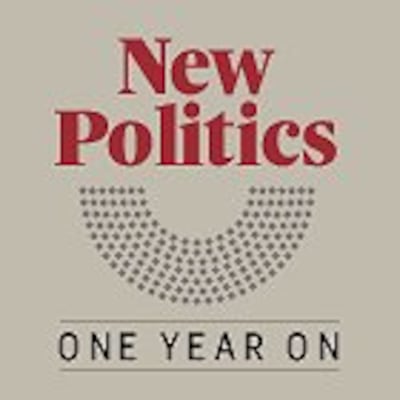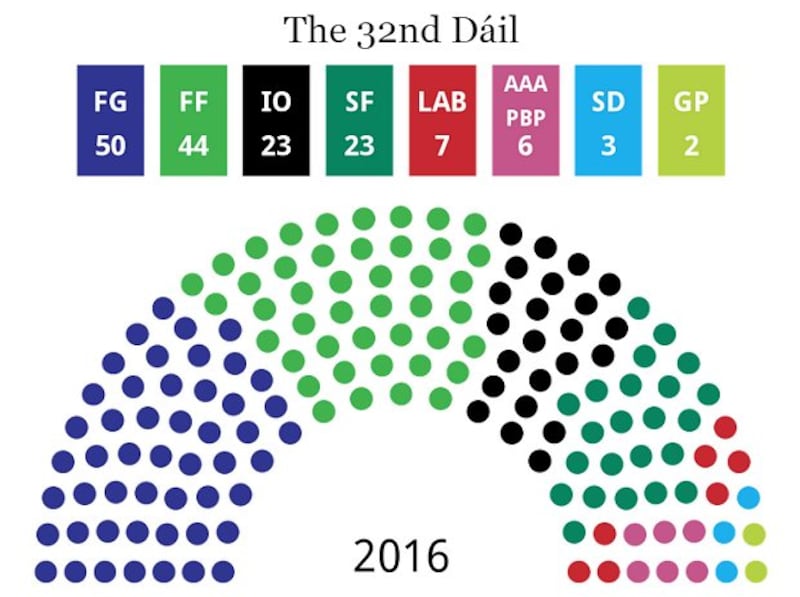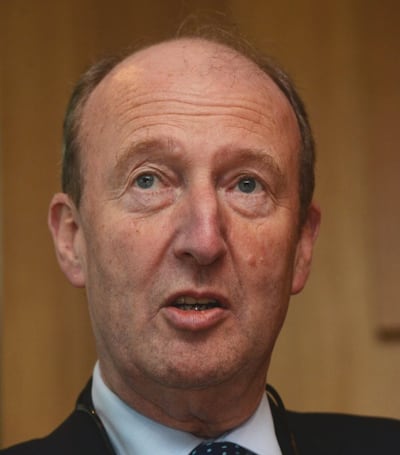
A year ago tomorrow, Ireland went to the polls for a general election that would provide the greatest upheaval in Irish politics since . . . well, since the previous election.
Irish politics has arguably undergone more change in the past decade than in the previous eight.
But the previous earthquake election of 2011 had replaced a decimated Fianna Fáil with the traditional alternative of Fine Gael and Labour. Twelve months ago, voters rejected that combination decisively, tearing up the old political playbook and opening up a new era in politics and government.
It was the election that nobody won. The result was a Dáil unlike any that went before, and – eventually – a Government unlike any we have seen before.
The votes were hardly counted when pundits were hailing the advent of “new politics”. But it soon became clear that that “new politics” had a highly elastic definition. It meant whatever you wanted it to mean.
David Begg, writing in The Irish Times a week after the general election and citing the hit television series Borgen, suggested that it could mean a more "Danish" style of politics. Whatever you think of the past year, it hasn't felt very Danish.
But what has it meant? What has the new politics done? What has it changed and what has remained the same? And, crucially, has it led to better government? These and related themes will be explored by Irish Times writers in a major series over the course of the next week.
Shocked faces
The shocked faces of the Taoiseach and his Fine Gael ministers at count centres around the country on February 27th, 2016, were evidence at least that the party had believed in the justice of its cause.
Even though the polls were unconvincing at best, Fine Gael ministers and election strategists believed that the strength of the economic recovery would guarantee them a return to power. The remarkable recovery in the state’s economic fortunes since the nadir of the 2010 bailout were testified to by a range of economic statistics: the fastest recovery in employment, the strongest growth in the EU, the rise in property prices, the strengthening of consumer and business confidence, and so on.
But the experience of many communities and individuals on the ground, especially in Fine Gael’s rural heartlands, was that the economic recovery was something on the news, not in their lives. They came, many of them, not just to dismiss the “Keep the Recovery Going” slogan, but to actively resent it.
For Labour, the result was perhaps more predictable, but more severe too. The party had known it was in a battle for survival but even still, the actual result – a reduction to just seven TDs, having won 36 in 2011 – was at the darker end of its direst imaginings.
The 2016 election result removed the Labour Party as a central player in Irish politics. Bringing the party back from the political periphery has been the work of its new leader Brendan Howlin. At best, that remains a work in progress.
Defenestrated
But if the voters had defenestrated the coalition, it was much less clear what they wanted to put in its place.
Three of the four main parties – Fianna Fáil, Fine Gael, Labour and Sinn Féin – were either disappointed or bitterly disappointed with the result. The fourth, Fianna Fáil, was happier, but more sober heads realised that the party was only returned to half its traditional size. The former Fianna Fáil minister Conor Lenihan boasted, “We’re baaaack!” But really, they were only half back.
The shock that had been administered to the political system as a whole, allied to the uncertainty provided by the new Dáil arithmetic, meant that when the 32nd Dáil met on March 10th, nobody really knew what it was going to do. It didn’t really know itself.
The Taoiseach, Enda Kenny, reeling from the loss of a third of his TDs, also knew that his position as leader of the largest party and sitting Taoiseach put him in a strong position to lead the next Government. But Kenny also knew the first faculty any politician needs is to be able to count; and when he counted, the reality of his situation was clear to him.
A grand coalition?
On April 6th, Kenny signalled the first departure of the new politics: he offered to share power with Fianna Fáil in a grand coalition – a “full partnership government”, he said. The offer was historic and unprecedented, a measure of just how much politics had been changed by the election result. But it was also made in the knowledge that it would probably be rejected.

Micheál Martin had consistently ruled out a Fine Gael-Fianna Fáil coalition during the election. He felt it would hand over leadership of the opposition to Sinn Féin, and that Fianna Fáil would suffer from being the smaller party in a Fine Gael-led coalition. More importantly, his party was resolutely against it.
Martin definitively rejected the grand coalition offer. But he offered to facilitate a Fine Gael minority Government if Kenny could secure the necessary eight independent votes that would give him a Dáil majority with a Fianna Fáil abstention. Seeing a lifeline, Kenny seized his chance. When the Lord closes the door, he opens a little window.
The new politics
Martin’s conditional offer, more than anything else, contained the blueprint for the architecture of the new politics.
Discussions with the Independents, previously meandering, got serious, and transactional. Michael Noonan lumbered into the room carrying the authority of his experience and the financial clout of his ministry. The Independents had a wish-list of local and national projects and causes they wanted to feature as priorities of the new Government.
I am the Minister for Finance, Noonan told them. I will write the Budget. I can make sure you get these things.
The Independents knew they might never hear another offer like this one. They signed on the dotted line. New politics might have changed some things. But it certainly hadn’t changed everything.
On May 6th, 70 days after the general election, Enda Kenny was re-elected Taoiseach by the Dáil.
Hopelessly unprepared
The long uncertainty of spring was followed by the shaky start of summer. The administration seemed hopelessly unprepared for taking office; indeed, the programme for government was not even printed as the Taoiseach’s nomination was being voted on.
Within weeks, the Government suffered a near-breakdown over abortion, when Independent Ministers refused to agree a Government position on a Dáil motion on abortion. The Attorney General had advised the bill was unconstitutional, but the Independents dug in, seeking a “vote of conscience”. The fact that this sought to set aside the constitutional principle of collective responsibility bothered Kenny, but not the Independents. Kenny acceded to their demands.

Independent Ministers have often served in government as powerful advocates for their own pet causes and issues – Beaumont Hospital, disabilities, judicial and state board appointments, Waterford cardiology services, etc. They have had rather more difficulty adapting to their role as Ministers of a collective cabinet Government.
Fine Gael’s levels of exasperation with the Independents fluctuate on a weekly basis, with many Ministers privately believing that the Independents – and Shane Ross in particular – simply are not suited to or interested in operating as a cohesive Government. Some of this is just politics; but it’s a fact that the arrangements of the new politics have undermined the cabinet system of government.
A slow, cumbersome Dáil
Within three weeks of taking office, the Government was defeated on a Private Members’ vote in the Dail, an event that was invested with some significance at the time. But nervous Ministers would have to get used to it. It soon became clear that the Government would be losing votes on a regular basis; last week, it lost four on one day.
This was the essence of the new politics: the simple fact that the Government of the day does not command a majority in parliament. And the coalition was not just a few votes off a Dáil majority: it was 20 votes away from it.
It wasn’t just that the Government would lose private members’ votes. It also lost the ability to manage the business of the house. A business committee, made up of representatives of all the Dáil groupings, now agrees the order of business by consensus. The result is a Dáil whose procedures are slow and cumbersome. The process of legislating has slowed to a trickle.
The only substantial piece of its own legislation this Government has passed since taking office is Simon Coveney's housing Bill
An analysis by Noel Whelan last month revealed that the present Dáil has passed just 18 Bills, the majority of which were either technical or procedural in nature. In fact, Whelan argued that apart from budgetary legislation, the only substantial piece of its own legislation that this Government has passed through the Oireachtas since taking office is Simon Coveney’s housing Bill, passed before Christmas after an arm-wrestle with Fianna Fáil. That is not just careful legislating; it is a slow-motion parliament.
New politics has inverted the power relationship between parliament and executive. Where previously the Government ruled the Oireachtas, now it needed the consent of the Dáil.
The Dail has not risen to that challenge. Many TDs remain resolutely locally focused; of those who aren’t, it would be hard to say that the new structures have elevated the pursuit of the national interest in their working week.
The power of the Opposition has largely been used to slow the work of Government. Privately, many senior civil servants believe that the experiment of a minority government has been an abject failure; some even say that they are reluctant to propose legislation because they are afraid that the Dáil will amend it beyond recognition.
Spending money to solve problems
But the work of government is more than just legislating. Government also runs the country on a day-to-day basis. The record is mixed: official and Government response to Brexit has been much criticised, but has been thorough and industrious, if sometimes light on the political front.
The Government agreed a budget, and stuck by it, even if its passage was greased by the discovery of several hundred million euros in Michael Noonan’s bottom drawer, a budgetary inflation that drew criticism from the Fiscal Advisory Council, the independent budgetary watchdog. It confirmed a pattern of spending money to solve problems.
If this is a failing of Government, it is one that is cheered on by the Dáil; every week there are motions and statements demanding more public funds be spent on a variety of causes, from big ones such as the health service to the small ones that litter oral questions and topical issues debates.
In that respect, the new politics is exactly like the old politics. Everyone has plenty of ideas to spend more money; commitment to maintain budgetary discipline remains the preserve of Government, and – usually but not always – of the Fianna Fáil TDs that support it.
There is no sign of the Independent Budgetary Office that would cost the proposals of Opposition as well as Government. That would change the terms of a lot of Dáil debate, but, like many of the hopes for the new politics a year ago, it remains a plan rather than a reality.
Sinn Féin, which hoped to lead the opposition, has been confined to a secondary role and is one of the chief critics of new politics
More than anyone else, the architect of the new politics arrangements was Micheál Martin, and, a year on, his party has reason enough to be satisfied with its progress. The party is polling strongly and is favourite to lead the next Government. Sinn Féin, which hoped to lead the opposition, has been confined to a secondary role and is one of the chief critics of new politics.
As Gerry Adams, honest but hardly eloquent, expostulated in the Dáil before Christmas: “New politics, my arse!”
The Independents outside government have the exact opposite view of the Independents inside politics, while Labour’s struggles make the new arrangements irrelevant to it.
And Fine Gael? New politics has returned it to power, but throughout the party there is a growing frustration with the arrangement. That the party is in the process of changing leader is not exactly an endorsement of the situation he led them into.
And all of the participants in the new system now wonder if it will survive his departure.
‘Borgen’ it ain’t
Political scientists say that Ireland has always fallen somewhere between the two classic models of democracy – the majoritarian (Westminster) model, and the consensus model, which typically features a multi-party landscape (rather than a two-party model), coalition governments and a balance between government and parliament.
Last year, writing in How Ireland Voted, an assessment of the election and its consequences by academics, two of Ireland's best-known political scientists, David Farrell and Jane Suiter, speculated that one of the outcomes of the election was that Ireland was moving definitively away from the Westminster model towards the consensus model. To a more Danish system, if you like.
Twelve months on, and Borgen it ain't. New politics has given us a new type of Government, a more equal relationship between the Dáil and the Cabinet. But it's hard to argue that it has given us demonstrably better government.
Different? Yes. Better? Hardly.


















